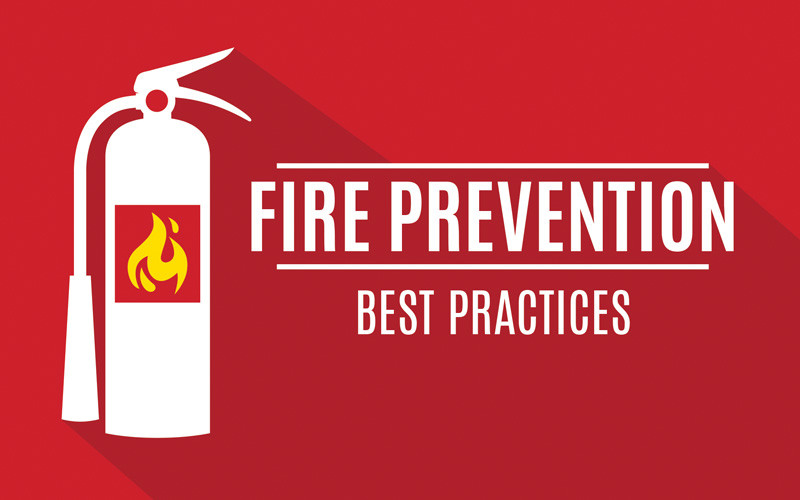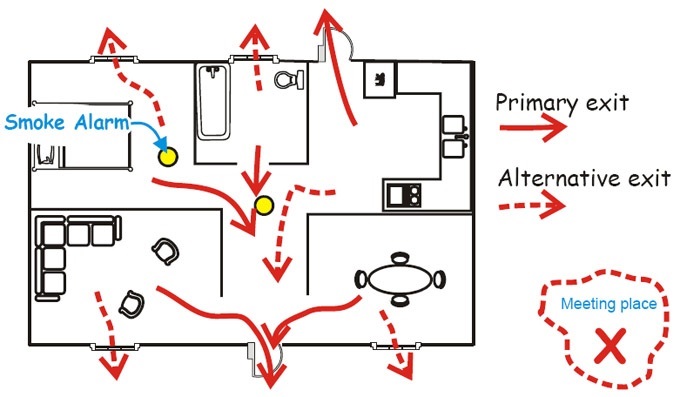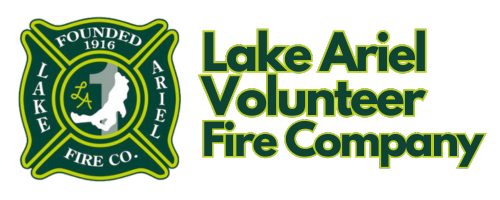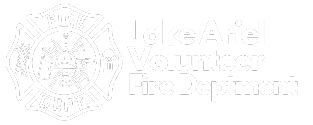Lake Ariel Fire Department Fire Prevention Bureau
The Lake Ariel Fire Department is committed to providing fire and life safety education to our diverse communities. If you are interested in meeting our firefighters and/or outreach and education team, contact the Fire Prevention Bureau, all requests should be made at least one month in advance. The minimum age for tours and visits is three.

- Fire Protection System - Out of Service
- Emergency Home Escape Planning
- Top Tips for Fire Safety
- Key fire safety tips
The Lake Ariel Fire Department must be notified when a building or premises presents a hazard to life or property as a result of a fire or other emergency, or when it is determined that any fire protection equipment or life safety system is inoperable, defective, inadequate, or has been taken out of service for more than eight hours in a twenty-four-hour period.
There are periods of time in which fire protection systems including fire sprinklers, fire alarm, special protection system, kitchen hood systems and others may experience system impairments. The purpose of this procedure is to provide guidance on how to prepare for and plan for system impairment. Fires that occur during a fire protection system impairment have a greater chance of causing major damage. Therefore, it is necessary to minimize the duration and scope of the impairment and to provide for alternate protection measures during the service or repair.
It is the responsibility of the building owner or designee to develop and implement an effective Fire Protection Impairment Procedure. Fire protection impairment procedures specific to your organization should be updated annually and include staff training, methods of monitoring and documentation, open communication between your staff, occupants, contractors, the fire department, and the insurance company.
Home Fire Escape Plan
Family members must know what to do in the event of a fire in their home. Unless a small fire can be easily controlled, it is recommended that fighting the fire be left to professional firefighters and that family members escape safely from the home.
A home escape plan must be created and practiced so that each person knows exactly what to do. It also is important to practice Exit Drills in the Home.
Most residential fires occur between 8 pm and 8 am. Deaths from residential fires occur in greater numbers between midnight and 4 am when most people are asleep. An average of 800 fires strike residential buildings each day in the United States. More than 6,500 persons die each year from fire – more than half of them children and senior citizens. The majority of these deaths are in home fires.
Regardless of the cause of the fire, a home may become filled with smoke. This is a very dangerous situation. Family members may be unable to see very well. The smoke and toxic gases may cause dizziness and disorientation. In the confusion, one can easily become lost or trapped in the home. Family members must understand that their safety depends upon quickly leaving the home. It has been proven that exit drills reduce the chance of panic and injury in fires. Trained and informed people have a much better chance of surviving fires in their homes.
Plan Ahead
- The normal exit
- The other exit through a door or a window
Plan an Escape Route 
Each member of the family should know how to get outside safely by at least two routes. Family members should practice opening their windows to become familiar with their operation. Jammed windows should be identified and repaired. If, during a fire, a window is jammed, it may be broken out with an object and a blanket or towel placed over the frame to cover shards of glass. It is much safer to open a window than it is to break the glass out. Never put locks or bars on windows or doors that cannot be opened from the inside.
Realize the Danger of Smoke
Establish a Safe Meeting Place
A special meeting place should be established at a safe distance from the house. It could be a mailbox, the neighbor’s driveway, or a large tree in the yard. Whatever it is, it must be something that is stationary and won’t be moved (such as a car). This is where everyone meets in the event of a fire. It prevents family members from wandering around the neighborhood looking for one another, or worse, being tempted to re-enter the burning house for someone thought to be trapped inside. Once outside at the special meeting place, a person can be sent to a neighbor to call 911. If anyone is missing, give that information to the fire department immediately and tell them where the probable location of the missing person could be. Under no circumstances should anyone re-enter the burning building.
Practice Your Fire Escape Plan
Exit Safely
Remember, Plan Ahead!
Remember, the first step toward escaping a fire is to plan ahead. Practice a home fire escape plan throughout the year and be sure that if anything should change around the home, it is included in the home fire escape plan.
Install smoke alarms on every level of your home, inside bedrooms and outside sleeping areas.
Test smoke alarms every month. If they’re not working, change the batteries.
Talk with all family members about a fire escape plan and practice the plan twice a year.
If a fire occurs in your home, GET OUT, STAY OUT and CALL FOR HELP. Never go back inside for anything or anyone.
Many home fires are preventable. If you’re working on a story about a fire in your community, feel free to include NFPA’s key fire safety tips in your article:
- Watch your cooking
Stay in the kitchen when you are frying, grilling, or broiling food. If you must leave, even for a short time, turn off the stove. - Give space heaters space
Keep fixed and portable space heaters at least three feet from anything that can burn. Turn off heaters when you leave the room or go to sleep. - Smoke outside
Ask smokers to smoke outside. Have sturdy, deep ashtrays for smokers. - Keep matches and lighters out of reach
Keep matches and lighters up high, out of the reach of children, preferably in a cabinet with a child lock. - Inspect electrical cords
Replace cords that are cracked, damaged, have broken plugs, or have loose connections. - Be careful when using candles
Keep candles at least one foot from anything that can burn. Blow out candles when you leave the room or go to sleep. - Have a home fire escape plan
Make a home fire escape plan and practice it at least twice a year. - Install smoke alarms
Install smoke alarms on every level of your home, inside bedrooms and outside sleeping areas. Interconnect smoke alarms throughout the home. When one sounds, they all sound. - Test smoke alarms
Test smoke alarms at least once a month and replace batteries once a year or when the alarm “chirps” to tell you the battery is low. Replace any smoke alarm that is more than 10 years old. - Install sprinklers
If you are building or remodeling your home, install residential fire sprinklers. Sprinklers can contain and may even extinguish a fire in less time than it would take the fire department to arrive.
Source: National Fire Protection Association (NFPA®)
Fire Station Tours
Station tours last approximately 20-30 minutes and include viewing the fire engine and equipment, talking to firefighters about their job and learning important fire safety tips. We can accommodate a maximum of 25 participants, including five chaperones (if children are in attendance). There must be one adult chaperone for every five children.
Requesting firefighters to visit your school
Schools may request a firefighter to visit their class. The minimum group size is 10 participants, and a maximum number of participants may be imposed depending on time and availability of fire department personnel. A parking area must be provided where the fire engine/truck can get in and out quickly in the event of an emergency. There must be one adult chaperone for every five children.
Requesting firefighters to attend your community event or parade
Fire Department participation can be requested for events that are open to the public, including health fairs, festivals and other educational events. Community event requests are scheduled as personnel are available. We do not participate in company-sponsored events or fundraisers.
We participate in parades as schedules allow. We may need to work with organizers on special apparatus placement during parades.
Station Tours, Firefighter Visits, and Community Events
Insufficient user capabilities (create_form_style)MAKE THE DIFFERENCE JOIN YOUR LOCAL FD
Join Today And Make A Difference In Your Community
© 2023 Copyright All Rights Reserved Lake Ariel Volunteer Fire Company 501(c) Not For Profit
Member (Login) | Website Designed by Market Genius USA

